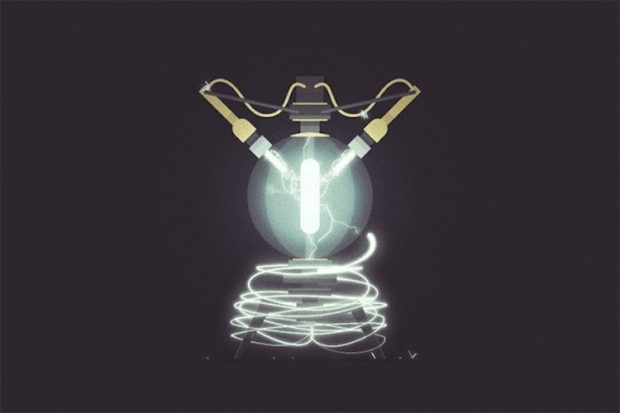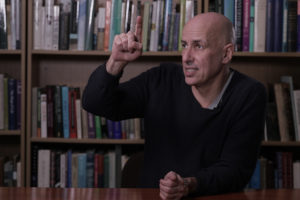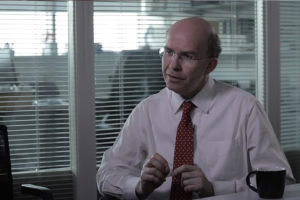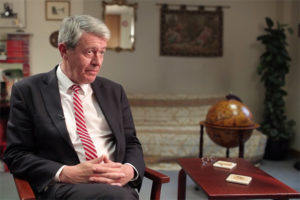Evolution of Popular Music
Evolutionary biologist Armand Leroi on the reconstruction of the history of music, revolutions in music and th...
In the middle of the decade for the 2000s – around about 2006 – some ideas came about that produced invisibility and cloaking, the idea that we could manipulate light in space to render objects invisible by guiding light around objects. A few years later at 2010 here, at Imperial College, my group examined the possibility that was related to the idea of manipulating light in just space.

We started to incorporate the time dimension into our analysis of how to manipulate electromagnetic fields. We have a very clear understanding of how to distort just space and how to incorporate or make a metamaterial that can make those distortions of reality such as an electromagnetic cloak. Our work expanded that to a more general transformation theory that incorporated not just space but the time dimension as well. So in an analogous fashion to distorting electromagnetic fields or light around an object we examined the possibility that we could distort light in spacetime. It’s a little bit harder to understand immediately what that might mean, what might a spacetime cloak mean.
I’d like to, first of all, say that whereas in the terms of a spatial cloak we’re hiding an object in space, when we’re dealing with spacetime if we’re hiding points in spacetime – that is the same as hiding events or happenings. A little like if I clap my hands – in some sense that event, it’s hidden from some observer. Maybe, the observer just sees my hands like this all the time and misses out that little moment when the clap occurs. Our work was directed towards the possibility of producing a cloak that could hide events. The kind of cartoon example I like to give that illustrates this is: imagine that you have a bank with a safe, you’ve got some CCTV camera that’s illuminating. If we were able to make a spacetime cloak we would be able to manipulate the light. There is a brief period of time for which no light actually is illuminating the safe. This allows a safe cracker to come in and steal all the cash, close the safe, and run away. While the CCTV camera just sees the safe closed all the time. A remarkable possibility.
Just to give it quite a good analogy as to how this works, imagine we’ve got cars going down the highway at a constant rate, a stream of cars. We change the speed at which cars are going so that a particular set of cars starts to move a bit quicker and some of the cars behind move a little bit slower. So there is a kind of gap opens up. The gap is the opportunity for something to occur in that cartoon way, we can imagine a chicken crossing the road. And then afterward those cars close up so that flow is recovered. So that someone downstream never actually knows that the chicken crosses the road. Of course, if the gap wasn’t opened up, the chicken would get run over and we’d know about it at downstream. But this idea of manipulating the flow of light, such that a gap can be opened up dynamically, is the basic idea of the so called spacetime cloak.
Just as the invisibility cloak that was proposed in 2006 exploited Maxwell’s equations and the properties of Maxwell’s equations to deduce what kind of metamaterial would be necessary to produce a cloak. In the spacetime arena it was Maxwell’s equations now in the full spacetime context, where we examined how the equations transform in space and time. That told us the recipe for making a metamaterial that could produce a spacetime cloak.
One thing to emphasize about the theory that goes into this – Maxwell’s theory – is that Maxwell’s theory is a dynamic theory, it fundamentally relates quantities that are evolving in space and time. In some sense, the spacetime transformation optics is the most complete description of transformation optics that we have. But when you apply that theoretical recipe to produce a spacetime cloak, it means that it imposes even more extreme technological challenges to make such a device than the original spatial cloak. It meant that we had to manipulate the properties of the material, not just in space, but also in time.
It didn’t actually hide very much time, it hid the Cornell experiment, hid twelve picoseconds, it’s 12*10-12 seconds. Not really enough for a bank heist, but nevertheless a very interesting demonstration of the concept. And that has been improved by the possibility of replicating a cloak not just once but many many times in rapid succession, that was demonstrated by a group that Purdue University a couple years afterwards.
In terms of where this has gone over the last few years, the Purdue experiment was in a sense the best that has been produced in a major experimental settings. So they were able to not just produce one cloak, but several cloaks in rapid succession, at several gigahertz rates. In a sense, the move towards making a temporal cloak longer is of less interest than keeping the timescales short and being able to reproduce the cloak rapidly. Because what we would like to do is to manipulate signals that you can have fast rates – the internet and so forth with a very large bandwidth. The experiments that use very rapid timescales are of most interest and continue to set considerable challenges.
But in terms of where this might be taking us, it introduces another paradigm for optical processing. One that allows us to have two or more channels operating where we can interrupt one channel and process on another channel, and then reconstitute the channel that has been interrupted so that the external observer only ever sees a continuous stream. For example, a cloaked signal can be expanded up, allow us to process during the gap on some other priority channel, and then that signal can be reconstituted. As far as the external circuit is concerned that priority channel has been processed instantaneously. So that’s kind of interrupt without interrupt facility to give an analogy. It’s as if I’m on a skype call and my wife calls on the telephone, it’s as if I can take the telephone call, and my colleague on the skype call is never aware that the interruption has taken place. But scaling that down to the micro-, nanolevel is what would potentially allow processing systems to occur more rapidly, and I think that’s quite exciting.

Just as with the spatial cloaking, I think, the technological penetration of, in fact, all cloaking ideas – spatial and temporal cloaking – are likely to be in systems that the end user is not necessarily going to be aware of immediately. In the case of temporal cloaking, it will allow us to have algorithms and processes that can be carried out simultaneously without parts of the algorithm being aware of each other. In some sense, the processing can occur in parallel and therefore quicker.
With the idea of temporal cloaking we have a possible functionality where we can interrupt signals and process other signals. This is an example where the technological penetration is of transformation optics and cloaking is likely to be at the level that the end user is not necessarily going to be immediately aware of, it might make your mobile phone work a little bit faster, due to the ability to process signals in different ways. But you won’t necessarily be aware of what the details of that technology are.
I think that it’s exciting that we’re able to do these things and we were able to demonstrate them in experiments. For the immediate future, I see the technological impact as being something that as end users we’re not necessarily going to be immediately aware of it. In these cases it will hopefully make our devices work better, our lives better, as well as some of these dark or nefarious ideas that I hope they will never be useful.

Evolutionary biologist Armand Leroi on the reconstruction of the history of music, revolutions in music and th...

Bioinformatician Tim Hubbard on the process of identifying genes, protein genes and RNA genes, and how many ge...

Neuroscientist Karl Friston on different types of brain measurement techniques, people's reaction to emotional...